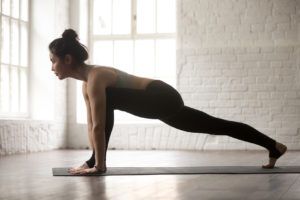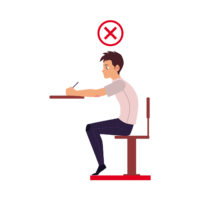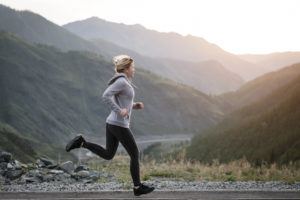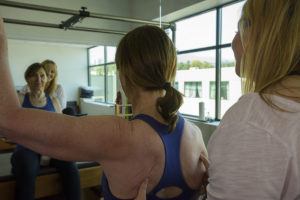Oh! Sweet Release! (Is It Really The Answer?)
“I seriously need to stretch and release my hips!”
We all have them. Those somewhat temperamental parts of the body that seem to need more attention than others. Those parts that tell on us when we’ve gone a bit overboard, or when we’re tired. Sometimes they just get grumpy for apparently no good reason. For many of us – that discomfort is a signal that we’ve got to pay attention. So we stretch, we roll with balls or rollers, we go for a massage, see the physio or chiropractor. And then? Ahhhh… sweet relief.
But wait a minute… it’s tomorrow, or next week, or next month… and we find ourselves complaining about the same tight bits! “Maybe I was sitting too long… I slept funny… I did that extra long run yesterday…” It must be time to stretch things out again, right?
Maybe. Or maybe not…
 When a part of your body is consistently showing up and telling you that it’s tight, sore and unhappy, that’s an indication that the remedy might involve more than a bigger, better stretch. When you begin to lose mobility that you once took for granted, your body is looking for support and stability. Your nervous system will help you find that support by creating it wherever it can. Stability trumps mobility every time. The trick is that the stability your body is crying for is likely needed somewhere OTHER than where you feel pain and discomfort. So when you stretch these consistently tight bits out, you’re treating the symptoms, and not the cause!
When a part of your body is consistently showing up and telling you that it’s tight, sore and unhappy, that’s an indication that the remedy might involve more than a bigger, better stretch. When you begin to lose mobility that you once took for granted, your body is looking for support and stability. Your nervous system will help you find that support by creating it wherever it can. Stability trumps mobility every time. The trick is that the stability your body is crying for is likely needed somewhere OTHER than where you feel pain and discomfort. So when you stretch these consistently tight bits out, you’re treating the symptoms, and not the cause!
Consider this:
Let’s say you’re dealing with chronically tight hips. You sit for long periods at work every day, and you love to run at least a few times a week. You’ve tried the “yoga for tight hips” clinics, and you’re diligent about stretching – but somehow you’re still fighting with those tight hips. Will they ever loosen up? Are they tight because of the running? Is it genetic? Well, maybe your mama had tight hips too, but I’d be willing to bet that there’s something more going on.
“Local” Stabilizer Muscles
Your musculoskeletal structure is made up of a couple functional “layers.” The deepest layer is the support musculature that creates local stability in the body. These muscles are typically relatively short, often connecting across a single joint. They are responsible for a “local” area – maintaining optimal relationships between individual bones. The deep spinal stabilizers are an example of local muscles; they stabilize and organize each vertebra of the spine relative to the vertebra above and below. When this happens well, the spine is segmentally supported, and the bigger global muscles are able to move it easily as an integrated whole.
Global Movement Muscles
The larger global muscles are responsible for actively moving our bodies around in space. These guys can stabilize too, but in a different way than the deep muscles. The global muscles are typically bigger, and tend to cross more than one joint. They’re responsible for bigger movement. Your quadriceps (thigh muscles) and your biceps brachii (arm muscles) are part of this system of locomotor muscles.
These global muscles can have a role in stability too – but they are each looking after more square footage of the body than those local muscles do. The global muscles are less about the relationships between individual bones, and more about supporting and moving larger zones of the body in a bigger way. The latissimus dorsi play an important role in standing and supporting our torsos in an upright position, for example. Strong quads are really useful in jumping and quick acceleration.
Balance is key
When all of these structures are doing their jobs well, we have a well organized system capable of stabilizing, mobilizing, activating and relaxing. We can move in just about any way we’d like to move, “with spontaneous zest and pleasure,” in the words of Joseph Pilates. When the balance gets mucked up somehow, through disuse, misuse, injury or illness, then our structures pay a price. As time goes on, and more compensations accrue, that structural price can get a lot steeper.
Revisiting those tight hips: a possible scenario for sitting
 During extended periods of sitting, we tend to slouch (come on, admit it!): tipping the pelvis back, rounding the shoulders forward, maybe even sliding down in the chair. Over time, our bodies adapt to this sitting position. The deep lumbar stabilizers (local muscles) can get stretched out because the pelvis is tilted back. Some of the larger, more superficial (global) back muscles tighten up to take up the slack.
During extended periods of sitting, we tend to slouch (come on, admit it!): tipping the pelvis back, rounding the shoulders forward, maybe even sliding down in the chair. Over time, our bodies adapt to this sitting position. The deep lumbar stabilizers (local muscles) can get stretched out because the pelvis is tilted back. Some of the larger, more superficial (global) back muscles tighten up to take up the slack.
Sometimes the back of the pelvic floor gets too tight, making it harder to connect to the deep core system for trunk stability. The hip flexors may be overactive in this position to keep the torso relatively upright when the core has stopped doing its job. Because we’re sitting on our duffs, the gluteal muscles get weak, compromising stability in the hips. At this stage, if the spine hasn’t started complaining yet, the sitting position may still feel ok.
What about running?
It’s when we stand up to move around, and go for a run that things get really interesting. If the core is weak, there’s little support for the lumbar spine. A tight pelvic floor and inner thigh muscles create a butt tuck which can provide for us at least some feeling of stability. With all that going on, the gluteal muscles – which are likely weak anyway – can’t activate well; meaning they can’t provide appropriate stability for the pelvis in standing.
The hip flexors are already short from all that sitting – so they won’t extend easily into a standing position. We add a little more butt tuck to give us the sensation of open hips – but that really just creates more tension. When we attempt to run, the legs can’t swing easily underneath us. We end up lifting the legs more from the hips , and getting our hip extension by over-extending the low back – none of which is great for optimal gait mechanics.
Adaptive range diminishes
 At each step along this path, the adaptive range in the body diminishes. Movement becomes more challenging and less efficient. Balance may suffer. We may begin to experience stiffness and pain. All along this path, compensating muscles are being asked to support a non-optimal loading strategy.
At each step along this path, the adaptive range in the body diminishes. Movement becomes more challenging and less efficient. Balance may suffer. We may begin to experience stiffness and pain. All along this path, compensating muscles are being asked to support a non-optimal loading strategy.
There’s no opportunity for the hip flexors to lengthen in this scenario! Due to a long chain of small, and perhaps unnoticed events, those hips become chronically overactive. The brain has created a pattern of compensation that requires them to participate in stabilizing the structure. A stretch may feel good in the moment – but it won’t change the physiological events that created the tension there in the first place. Any relief we feel will likely be short lived.
It’s about HOW you move
The kind of change that makes a sustainable difference may require a deconstruction of old patterning, some re-education around new, more optimal patterns, and some mindful, intentional and consistent practice to build the capacity to support those new patterns. It sounds like a herculean task – but really it’s about becoming conscious of HOW we’re moving, and then refining what we’re doing. A stretch may be part of the picture, but in many chronic cases, it’s not the whole story.
Our bodies are wonderfully adaptable things. Our adaptability allows us to reorganize ourselves around problems – keeping us going instead of stopping us cold. But when that adaptive range diminishes around compensations, we experience tissue tension. Small shifts in fascial tension, changes in visceral mobility/motility, dysfunctional posture or movement patterning, injury, illness, poor nutrition, fatigue, stress to the nervous system: any and all of these may have an impact on our sense of ease or tension in the system.
Our structures may seem pretty static – but in reality they are moving, evolving, adapting and changing all the time. This is a good thing! When we can become attuned to that process, we have better success in managing what’s working well, and understanding what needs different kind of approach. When we learn how to connect to ourselves in this way, we have an amazing capacity to regulate and support our structural health as we navigate our fitness over a lifetime. It’s a longevity skill worth learning!
Give your body some LOVE!!!
 So if a stretch feels good and it does the trick – keep doing it! (I love a really good stretch!) But if you’re running into the same tensions a lot; and stretches, rolling, and various other treatments don’t seem to be shifting or relieving that tension, then it might be worth your time to explore WHY things feel tight. What are the other players in the problem?
So if a stretch feels good and it does the trick – keep doing it! (I love a really good stretch!) But if you’re running into the same tensions a lot; and stretches, rolling, and various other treatments don’t seem to be shifting or relieving that tension, then it might be worth your time to explore WHY things feel tight. What are the other players in the problem?
If you’re inspired to play with this stuff, an experienced Pilates instructor or movement professional can help you identify problems, and explore new strategies to get better, more sustainable results! It’s more than just stretching what hurts. Check out Moving Spirit’s Pilates Mat Classes, Reformer Classes and Private Pilates Training for more information about our programs, or book an Introductory Private Training Package today.
Try it – your body will LOVE you for it!
#howyoumovematters
About Susannah Steers
 Susannah is a Pilates and Integrated Movement Specialist, and owner of Moving Spirit. Through movement teaching, speaking and facilitating workshops, she supports people in creating movement practices that promote fitness from the inside out. Susannah co-hosts The Small Conversations for a Better World Podcast; an interview-based podcast dedicated to promoting conversations about health that can spark positive change in individuals, families, communities and across the globe.
Susannah is a Pilates and Integrated Movement Specialist, and owner of Moving Spirit. Through movement teaching, speaking and facilitating workshops, she supports people in creating movement practices that promote fitness from the inside out. Susannah co-hosts The Small Conversations for a Better World Podcast; an interview-based podcast dedicated to promoting conversations about health that can spark positive change in individuals, families, communities and across the globe.
